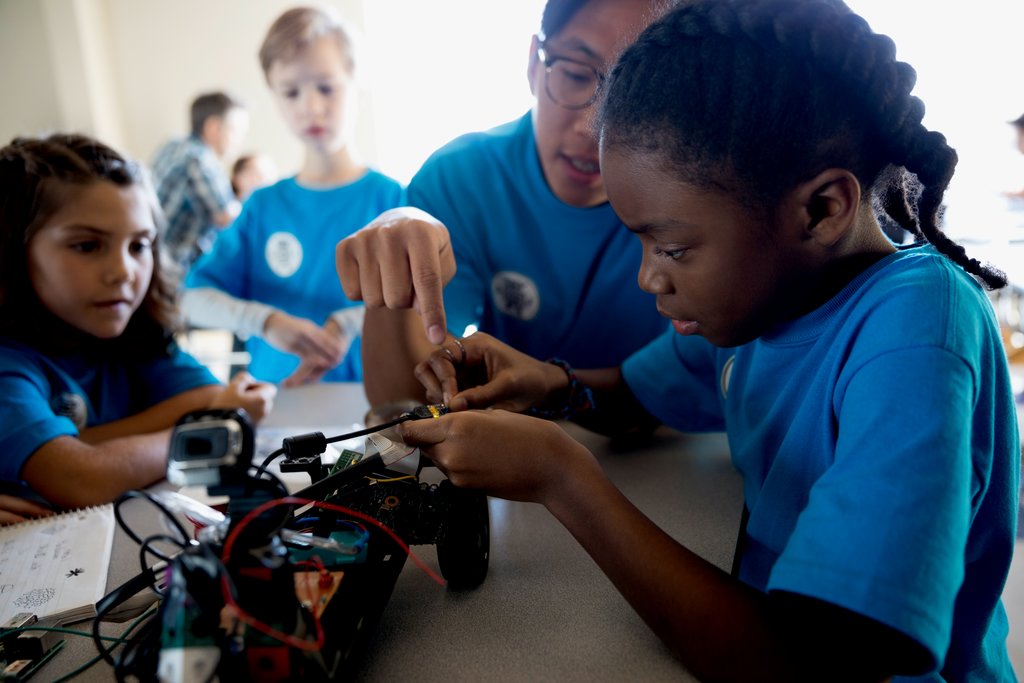Three ways to break the gender bias in STEM.

Today is Women's Equality Day, and this year’s theme is an important one: Break the Bias.
As a math teacher and advocate for women in STEM with a Master’s degree in mathematics education, I can assure you that whether deliberate or not, gender bias presents a huge obstacle for women in STEM. Though we have made significant strides towards equity and equality, women still face countless barriers when it comes to receiving fair and equal treatment or moving ahead either individually or collectively. Bias is a major obstacle when it comes to closing gender gaps in STEM fields, but the good news? Bias can be broken.
Despite the progress that has been made, I still hear people questioning: “Does gender bias even exist in STEM anymore? I mean, my math teacher was a woman, and I see female scientists in the news.” And to that I want to shout from the rooftops: Yes, gender bias still exists in stem! Big time!
Bias can be as unconscious as assuming that someone isn’t smart because of how they look or dress, or as conscious as making the choice to not hire someone because of the belief that women aren’t as smart, or STEM oriented as men. Hopefully you’re eyerolling right now, but trust me, many people actually believe that. Gender bias in STEM is still alive, but the good news is that there is something we can all do about it - and there’s no better day to start than today.
Here are 3 ways you can take a step toward fighting gender bias in STEM:
1. Know the facts, understand the issue
The first step you can take toward fighting gender bias in STEM is getting educated on the facts.
I was on vacation a few years ago when another traveler overheard me talking about gender bias in STEM. He interrupted to tell me I was mistaken, there was no gender bias in STEM. His proof? He had a few female friends in science-related fields. That was it. That was his proof. I explained I had a Master’s degree in math education, with the STEM gender gap as an area of my study, but he wasn’t swayed. In my shock and anger I couldn’t recall any solid facts or numbers to throw at him, and to this day I still think about it.
My point is, this guy had zero facts. I like to hope that if he had been presented with some actual information, perhaps he would have reconsidered his stance. Here’s what I wish I said:
Did you know that:
- Women are typically given smaller research grants than male colleagues? Or that around 1/3 researchers are women1 and only 12% of members of national science academies are women?2
- Women make up only 28% of the workforce in science, technology, engineering and math?3
- Engineering and computer science, two of the most well-paying STEM fields, remain heavily male dominated with only 21% of engineering majors and 19% of computer science majors being women.
- In STEM fields, men’s annual salaries are nearly $15,000 higher per year than women, and Latina and Black women in STEM earn around $33,000 less than men.4
If there’s one thing that my travel experience taught me, it’s that anecdotal evidence - evidence based on an individual’s experience - is often faulty and inaccurate. This is why it is essential that we prepare ourselves with facts and knowledge if we want to truly make an impact and enact change. Today, take a little time to research a few facts about the gender bias that exists in STEM so you can be ready with the knowledge needed to start a conversation or make a difference.
“When I was an application engineer demo’ing abrasives product, I was asked ‘Are you strong enough to be using power tools?’ In addition to being impressed by the products, they were surprised that ‘a girl’ can use a right-angle grinder to level a weld. The focus was on my gender rather than my abilities.”
-Judy Wong, Global Product Engineering Leader, 3M Abrasive Systems Division
2. Call it out
Knowing our facts and statistics is the first step, the next is standing up and saying something. We need people to take action in calling out bias, discrimination, and stereotyping every step of the way. The truth is, many people are simply unaware that gender bias exists, and even if they are, they may not know exactly what it looks like. So, what can you do? Call it out, point it out, draw attention to it, and make it clear that it is not okay. For example, say you’re in your workplace and someone makes a sexist joke. Instead of rolling your eyes and moving on, take a beat, and point out that the joke is sexist and offensive. Ask the person who told it - or the person who laughed at it - why it’s funny in the first place. I like this approach because it generates conversation and when everyone feels involved, it’s more likely that you’ll come to a positive resolution. Casual sexism is a major source of gender bias, and it’s harmful. Calling it out when you see it can interrupt the narrative and highlight the ways gender bias presents itself in our daily lives.
Calling out bias can also take the form of activism or awareness-campaigning. One of my favourite things to do is write to companies whose products or advertisements promote gender bias. Engaging people in respectful discussion is effective because it promotes a conversational, open interaction rather than defensive, confrontational one. If you see something that promotes gender bias, post about it, reach out to the person or company who created it, Tweet about it, talk to your friends about it. Raising awareness and starting a conversation can result in the change we wish to see.

3. Share your story and ignite a spark in someone
STEM champions don’t just point out the path forward; they help make the journey possible.
One of the key differences between role models and champions is action. When I think back to how hard it was for me to believe in my ability to do math when I was younger, I am endlessly grateful for my Grade 12 math teacher. She didn’t just stand at the front of the class and show me that women can do math, but instead she took the time to mentor me, give me additional resources like practice problems and math contests to pique my interest, and actually spoke to my parents for me when I didn’t know how to communicate with them myself. She made sure I had the opportunity to discover my math superpowers and to build the confidence I needed to succeed.
Since Grade 12, I have made it a goal of mine to be a champion for others. Whether that means providing math support to those who need a little guidance, writing reference letters for my students, sharing my story with students and teachers across Canada, or giving young, diverse women the opportunity to tutor for my company, The Math Guru. I strive to be a STEM champion in every way I possibly can. Yes, I want to show students everywhere that math belongs to us all - but I also want to take action in making that vision a reality for as many people as I can. How can you share your story and ignite a spark in someone today?
If you have a passion for science, engineering, and finding solutions to technical problems; if you want to work in a field where you can actually make stuff that you can see and touch and hold, go for it! It’s a very rewarding career, that can be much fun along the way.
-Adriana Gorgan, Chemical Engineer M.A.Sc
Senior Specialist, Global Product Engineer, 3M Abrasive Systems Division
So there you have it. Three ways to start moving the needle when it comes to addressing gender bias not just in STEM - but everywhere. Intention is one thing, but action is what is really needed to make impactful, lasting change. We all have a different comfort level when it comes to being a STEM champion and it’s important to remember that you don’t have to be picketing on the frontlines to make a difference. Taking one of the steps suggested in this post is a step in the direction of fighting for a world free of gender bias, so pick an option that resonates with you, and GO FOR IT!
References
- UNESCO – Just 30% of the world’s researchers are women. https://en.unesco.org/news/just-30-world%E2%80%99s-researchers-are-women-whats-situation-your-country
- International Development Research Centre (Canada) – Women in Science. https://www.idrc.ca/en/research-in-action/women-science
- AAUW – The STEM Gap: Women and Girls in Science, Technology, Engineering and Mathematics. https://www.aauw.org/resources/research/the-stem-gap/
- Pew Research Center – Women and men in STEM often at odds over workplace equity. https://www.pewresearch.org/social-trends/2018/01/09/women-and-men-in-stem-often-at-odds-over-workplace-equity/ps_2018-01-09_stem_a-09/
Vanessa’s blog is part of a paid sponsorship agreement with 3M Canada.